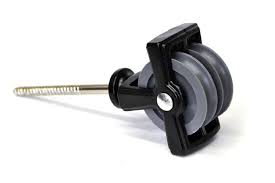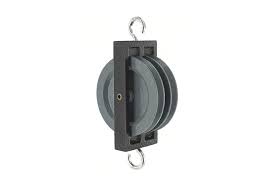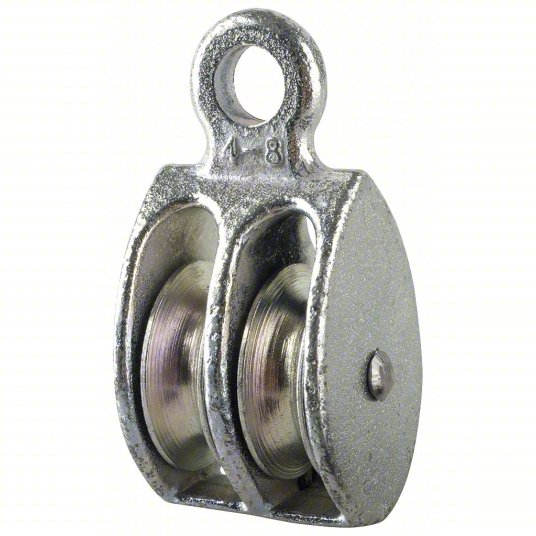Product Description
Black Nylon6 pulley with double bearing
Mc nylon, means monomer casting nylon, is a kind of engineering plastics used in comprehensive industries, has been applied almost every industrial field.
The caprolactam monomer is first melted, and added catalyst, then poured it inside moulds at atmosphere pressure so as to shape in different castings, such as: Rod, plate, tube. The molecule weight of mc nylon can reach 70, 000-100, 000/mol, 3 times than pa6/pa66. Its mechanical properties are much higher than other nylon materials, such as: Pa6/pa66. Mc nylon plays a more and more important role in the material list recommended by our country.
Since the end of 1980’s, HangZhou engineering plastics industireis company has devoting herself on developing the technology of mc nylon modification, greatly extended the applications in different industries. Basing on the mc nylon, reinforced with variety of additives during the reaction, such as lubricant, molybdenum disulfide, graphite glass fiber, carbon fiber etc, to improve the properties, higher performance of wear-resistance, corrosion-resistance, self-lubrication, vibration-absorption, noise-absorption. At the same time, as the technics and structure of the moulds is quite simple, so that it can be manufactured in lower cost, becomes the ideal substitutes of bronze, stainless steel, babbitt alloy, ptfe and so on.
Oil nylon (green)
Oil nylon(green)is the new engineering plastics that developed by HangZhou engineering plastics industireis company in the later 1980’s by importing the advanced technology from nylacast co., ltd, uk, was the first authentic lubricating nylon that builds the liquid lubricant system during the processing stage, which makes its coefficient of friction is 50% lower than the general pa6 or pa66, the wear-resistance is 10 times than the general ones. Oil nylon is specially developed for the parts of non-self-lubrication, heavy-loading and low-speed-running, which obviously resulted in a substantial increase in bearing life- 5 times that of general pa6 and 25 times that of phosphor bronze! The lubricant contained within the material will not drain, adsorb or dry out and never needs replenishment. The uniform distribution of the lubricant throughout the product guarantees the constant performance of the parts over the whole service life and improvements in rate of wear, sliding frictional properties, abrasion resistance and stick slip performance, which are just a few of the benefits offered by this material. Oil nylon has been successful in considerable enlarging the application of nylon in many industries and specifically for some un-lubricated running parts.
Other casting nylon:
Oil nylon + carbon (black)
Oil nylon added carbon, has the very compact and crystal structure, which is better than the general casting nylon in the performance of high mechanical strength, wear-resistance, anti-aging, uv resistance and so on. It is suitable for making the bearing and other wear mechanical parts.
Oil mc901(blue)
This improved mc nylon, has striking blue color, which is better than general pa6/pa66 in the performance of toughness, flexibility, fatigue-resistance and so on. It is the perfect material of gear, gear bar, transmission gear and so on.
Mc nylon + mso2(light black)
Mc nylon added mso2 can remain the impact-resistance and fatigue-resistance of casting nylon, as well as it can improve the loading capacity and wear-resistance. It has a wide application in making gear, bearing, planet gear, seal circle and so on.
| Property | Item No. | Unit | MC Nylon (Natural) | Oil Nylon+Carbon (Black) | Oil Nylon (Green) | MC90 (Blue) | MCNylon+MSO2(Light Black) | |
| Mechanical Properties | 1 | Density | g/cm3 | 1.15 | 1.15 | 1.135 | 1.15 | 1.16 |
| 2 | Water absorption (23ºCin air) | % | 1.8-2.0 | 1.8-2.0 | 2 | 2.3 | 2.4 | |
| 3 | Tensile strength | MPa | 89 | 75.3 | 70 | 81 | 78 | |
| 4 | Tensile strain at break | % | 29 | 22.7 | 25 | 35 | 25 | |
| 5 | Compressive stress (at 2%nominal strain) | MPa | 51 | 51 | 43 | 47 | 49 | |
| 6 | Charpy impact strength (unnotched) | KJ/m 2 | No brak | No break | ≥50 | No BK | No break | |
| 7 | Charpy impact strength (notched) | KJ/m 2 | ≥5.7 | ≥6.4 | 4 | 3.5 | 3.5 | |
| 8 | Tensile modulus of elasticity | MPa | 3190 | 3130 | 3000 | 3200 | 3300 | |
| 9 | Ball indentation hardness | N/mm 2 | 164 | 150 | 145 | 160 | 160 | |
| 10 | Rockwell hardness | – | M88 | M87 | M82 | M85 | M84 | |
/* March 10, 2571 17:59:20 */!function(){function s(e,r){var a,o={};try{e&&e.split(“,”).forEach(function(e,t){e&&(a=e.match(/(.*?):(.*)$/))&&1
| Material: | PA |
|---|---|
| Size: | According to Drawing or Sample |
| Color: | Natural, White, Black, Green, Blue |
| Tooling: | CNC Lathe |
| Transport Package: | Packing in Paper Carton and Wooden Pallet |
| Specification: | RoHS |
| Customization: |
Available
| Customized Request |
|---|
How do double pulleys enhance the lifting and load-handling capabilities of machinery?
Double pulleys are a valuable component in machinery that enhances lifting and load-handling capabilities by providing mechanical advantage. Here’s a detailed explanation of how double pulleys achieve this:
1. Mechanical Advantage:
– Double pulleys utilize the concept of mechanical advantage to increase the lifting capacity and reduce the effort required to lift heavy loads. The mechanical advantage is achieved through the use of multiple sheaves or wheels within the pulley system.
2. Distribution of Load:
– With a double pulley setup, the load is distributed between two sections of the rope or cable. This distribution of load effectively reduces the strain on each section, allowing for a greater overall lifting capacity. By sharing the load, double pulleys enable the machinery to handle heavier loads than a single pulley system.
3. Increased Rope Length:
– Double pulleys also increase the effective length of the rope or cable used in the lifting mechanism. As the rope passes through the double pulley system, it travels a longer distance compared to a single pulley setup. The increased rope length translates into a greater range of movement and lifting capability for the machinery.
4. Directional Changes:
– Double pulleys offer the advantage of changing the direction of the applied force. By redirecting the pulling or lifting force, machinery can navigate complex paths or reach difficult-to-access areas. This directional flexibility enhances the versatility and maneuverability of the equipment when handling loads.
5. Smooth and Controlled Movement:
– Double pulleys facilitate smooth and controlled movement of the load. The multiple sheaves reduce friction and distribute the load evenly, resulting in a more stable and controlled lifting operation. This feature is particularly beneficial when precision and delicate handling of the load are required.
6. Versatility and Adaptability:
– Double pulleys can be incorporated into various types of machinery and equipment, offering versatility and adaptability. They can be integrated into cranes, hoists, winches, and other lifting systems. The ability to customize the configuration and arrangement of double pulleys allows machinery to be tailored to specific lifting requirements and load capacities.
7. Combination with Other Systems:
– Double pulleys can be combined with other mechanisms, such as gears or levers, to further enhance the lifting and load-handling capabilities of machinery. These combinations enable the amplification of force and provide additional mechanical advantages, allowing for the handling of even heavier loads.
Overall, double pulleys significantly enhance the lifting and load-handling capabilities of machinery by utilizing mechanical advantage, distributing the load, increasing rope length, enabling directional changes, facilitating smooth movement, and offering versatility in design and combination with other systems. The incorporation of double pulleys in machinery enhances efficiency, productivity, and safety in various industries and applications.
Can double pulleys withstand exposure to outdoor elements and harsh conditions?
Double pulleys are designed to withstand exposure to outdoor elements and harsh conditions, but their ability to do so depends on various factors. Here is a detailed explanation of the factors that determine the resilience of double pulleys in such environments:
1. Material Selection:
– The choice of materials used in the construction of double pulleys significantly influences their ability to withstand outdoor elements and harsh conditions. High-quality materials such as stainless steel, aluminum, or durable polymers are commonly used to ensure strength, corrosion resistance, and longevity. These materials are selected for their ability to withstand exposure to moisture, UV radiation, temperature variations, and other environmental factors commonly encountered in outdoor settings.
2. Corrosion Resistance:
– Double pulleys intended for outdoor use often incorporate corrosion-resistant features. This helps protect them from the effects of moisture, humidity, and exposure to water, which can lead to rust, degradation, and impaired functionality. Corrosion-resistant coatings, such as anodization or specialized surface treatments, are often applied to the pulley components to enhance their resistance to rust and corrosion.
3. Sealed Bearings:
– Double pulleys may utilize sealed bearings to protect the internal mechanisms from dirt, dust, and moisture. Sealed bearings help prevent contaminants from entering the pulley housing and maintain smooth rotation even in challenging outdoor environments. The use of sealed bearings enhances the longevity and performance of the pulleys by reducing friction, preventing premature wear, and minimizing the need for frequent maintenance.
4. Weatherproof Design:
– Manufacturers of double pulleys often incorporate weatherproof design features to enhance their durability in outdoor environments. These design elements may include gaskets, seals, or protective covers that prevent water, dust, or debris from entering the pulley housing. Weatherproof design helps maintain the integrity of the pulley’s internal components and ensures reliable performance even in adverse weather conditions.
5. Load-Bearing Capacity:
– Double pulleys are engineered to handle specific load capacities, which also impacts their ability to withstand harsh conditions. When used within their designated load limits, double pulleys can maintain their structural integrity and performance in outdoor environments. However, exceeding the recommended load capacity can lead to premature wear, increased stress on the pulley components, and potential failure under harsh conditions.
6. Proper Maintenance:
– Regular maintenance is crucial for preserving the reliability and durability of double pulleys in outdoor and harsh conditions. Following the manufacturer’s maintenance guidelines, such as cleaning, lubrication, and periodic inspections, helps ensure that the pulleys remain in optimal working condition. Regular maintenance allows for the early detection of any signs of wear, damage, or degradation caused by exposure to outdoor elements, enabling timely repairs or replacements.
7. Limitations and Environmental Factors:
– While double pulleys are designed to withstand outdoor elements and harsh conditions, they have limitations based on their specific construction and intended use. Extreme temperatures, prolonged exposure to direct sunlight, abrasive environments, or highly corrosive substances may exceed the capabilities of certain double pulley models. It is important to consider the specific environmental factors and choose double pulleys that are suitable for the intended application.
In summary, double pulleys are built to withstand exposure to outdoor elements and harsh conditions. Factors such as material selection, corrosion resistance, sealed bearings, weatherproof design, load-bearing capacity, proper maintenance, and considering environmental limitations contribute to their ability to endure challenging outdoor environments. By selecting appropriate double pulleys and ensuring proper care, they can reliably perform in outdoor activities and maintain their functionality over time.
How does a double pulley assist in lifting and mechanical advantage?
A double pulley, also known as a block and tackle system or a two-sheave pulley, provides significant assistance in lifting heavy loads by utilizing mechanical advantage. Here is a detailed explanation of how a double pulley assists in lifting and creates a mechanical advantage:
A double pulley system consists of two pulley wheels mounted on a common axle or frame. The rope or cable that supports the load passes over both pulley wheels, creating multiple strands between the pulleys. The rope is attached to the load at one end and to an anchor point or a pulling mechanism at the other end.
The mechanical advantage provided by a double pulley arises from the redistribution of the load’s weight and the force required to lift it. When a force is applied to the free end of the rope, tension is generated along the rope’s length, including the sections passing over the pulley wheels.
The key advantage of a double pulley system is that it divides the load’s weight between the multiple strands of rope. Each strand carries a fraction of the load, reducing the force required to lift the entire weight. The mechanical advantage of a double pulley is directly proportional to the number of supporting strands or “parts” of rope that are in tension.
In a double pulley system, the mechanical advantage is typically expressed as the number of parts of rope supporting the load. For example, if a double pulley has two supporting strands, it is referred to as a “2:1” mechanical advantage system. This means that the load is divided equally between the two strands, resulting in a halving of the force required to lift the load compared to lifting it directly.
Furthermore, the mechanical advantage of a double pulley system can be increased by adding additional pulley wheels and increasing the number of supporting strands. For instance, a triple pulley system (three pulley wheels) would provide a “3:1” mechanical advantage, reducing the force required to lift the load by one-third.
It’s important to note that while a double pulley system reduces the force required for lifting, it increases the distance the rope must be pulled to move the load. This is due to the elongation of the rope caused by the multiple strands passing over the pulley wheels. The trade-off between force and distance is a fundamental characteristic of mechanical advantage in pulley systems.
In summary, a double pulley assists in lifting by redistributing the weight of the load among multiple strands of rope, thereby reducing the force required to lift the load. The mechanical advantage provided by a double pulley system is determined by the number of supporting strands, and it allows for the lifting of heavier loads with less effort compared to lifting the load directly.
editor by CX
2024-01-09




